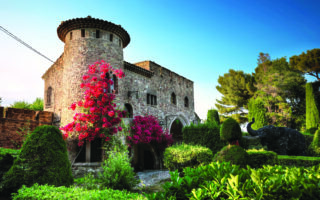The Living France Guide to Food
Food is taken very seriously in France so, for those making the move, Kate McNally gives us the low-down on tastes and culinary traditions across the Channel
In France, food is much more than sustenance: it is pleasure, celebration, conversation, tradition, pride, comfort, nurturing and sharing. Put simply, food is as integral to the fabric of French society as cheese to a croque-monsieur and, when it comes to integrating with our Gallic cousins, it helps enormously if you understand that from the off.
We all know the country is famed for its cuisine, which remains a benchmark for global gastronomy, but there are changes afoot. The dominance of supermarket chains and the faster pace of modern life dictating quicker and easier eating habits have not bypassed France. That said, like Napoleon at Waterloo, the French are not about to give up centuries of fantastic food and long digesting hours without a fight.
EATING HABITS Eating patterns are changing and there are differences between town and rural life, between older and younger generations, and depending on whether two or only one parent in a family go out to work. In general, however, the typical French family will still sit down together for a meal at least once a day.
The meal will usually consist of three courses – a starter, main course and either cheese, fruit or dessert. And of course, no French meal could call itself such without the ubiquitous hunk of pain de campagne or baguette. At the table, children mostly drink water and adults water and/or wine. French children in general only drink fizzy drinks or squash between meals or as part of the ap�ro (see below).
The long lunch hour continues in much of France, particularly in more rural areas where workers, based locally, will head home for lunch or pop into the local eatery. Either way, it is common for businesses, both public and private, to shut up shop from noon until 2pm, so even if you didn’t particularly want to go native, often there isn’t much alternative – your employer will quite likely expect you to take two hours for lunch and with all the shops and services closed over this period, you may as well go with the flow and have a leisurely lunch. It might be frustrating at first that you can’t get all those little jobs done – buy supper, call in at the post office – but most newcomers to France soon start to enjoy the excuse for a restful midday break.
Breakfast, meanwhile, is an altogether faster affair – black coffee, chocolat chaud or juice and a viennoiserie (the collective name for croissant, pain au chocolat or pain au raisin) of choice consumed with minimal pomp and ceremony. Cereals compete increasingly for the breakfast share with an impressive variety lining supermarket shelves but there is no French equivalent to a bacon butty or mid-morning fry-up with all the trimmings. On the breakfast front at least, a full English reigns supreme in Europe!
EATING OUT The French have a thriving caf� culture and until recently it was also common for the majority of the population to regularly eat out at a restaurant. Even students could afford to treat themselves to the cheapest three-course set menu including wine a decade or so ago.
However, the advent of the euro increased prices across the board, restaurant prices included, and as the European banking crisis continues to squeeze the average person’s disposable income, even regular restaurant-goers are forced to cut back their visits.
Most restaurants try to offer a good-value set menu option alongside the � la carte option, and very often it is not much more expensive than a meal from a fast-food outlet. Even so, what used to be part of the weekly or even daily budget has now become a monthly treat for many people in France, similar to dining out in the UK.
Very different from the UK, however, is the paucity of foreign fare on offer. Apart from pizzas, tagines and, increasingly in recent years, a growing availability of Asian food, very little international cuisine has established itself at the French table. Mind you, it should be noted that French cuisine already incorporates a variety of influences from across its various borders, from Mediterranean flavours in the south to Germanic recipes in the north-east. If you’re after a curry though, unless you live in a major city, you could be waiting a while!
SHOPPING HABITS Luckily the French are taking longer than many countries to succumb to the all-powerful nature of the modern supermarket trade. Planning laws have protected the local high street by insisting supermarkets are built in commercial zones in the outskirts of towns. Many of the major chains have, however, developed smaller-scale offers such as Carrefour Contact and Petit Casino, which are the equivalent of Tesco Metro and give them greater local access. But their bigger siblings remain out of town, and that goes a long way towards protecting the butcher and the baker (if not the candlestick maker), together with the newsagent and post office, that continue to be staples in even the smaller villages.
MARKETS The popularity, diversity, price-competitiveness and commitment to regional produce of local food markets are likely to ensure that this stalwart of French culture never dies out – fingers crossed!
The markets have long been the backbone of village social life, simultaneously providing a lively ambience that attracts people from near and far to gather and chew the cud as well as an important economic centre for local producers and artisans.
Locals love them as much as tourists and it is common practice for French people to combine a weekly supermarket visit with a market shop for fresh produce and local specialities. Larger towns and cities have a twice-weekly or daily market, and so far they are holding their own. They have an advantage over the farmers’ markets in the UK in that the French never lost the habit, nor the pleasure, of sauntering among the stalls and bantering with their owners.
REGIONAL SPECIALITIES All corners of l’Hexagone have regional specialities which are heralded at every opportunity. And rightly so, for these foods and wines are an important part of the local identity and play a key role in terms of tourism and the local economy.
French people, in particular, will always seek out renowned local specialities and expect them to feature prominently in restaurant menus. From duck and Armagnac in Gers, to cr�pes and galettes in Brittany, and to bouillabaisse and a fine ros� in the south, not to mention the 300-plus varieties of cheese, the culinary diversity is there to be explored and enjoyed.
French producers are proud of this heritage and have established a system of quality ‘labels’ to help buyers identify the best products. That said, as mentioned above, you are always likely to find the finest local products at the market.
TRADITIONS Perhaps the most cherished social occasion for eating and drinking is the ap�ritif gathering, known as the ap�ro. A precursor to a longer meal or a stand-alone event, it can range from a few crisps and olives and a glass of wine to a mini buffet with saucissons, tapenades, blinis and champagne served with the local liqueur. Mostly, however, it is an excuse to imbibe a few more glasses than usual and relax with friends, family or colleagues.
The French also like to share a good meal and it’s one of the most popular ways to spend quality time, especially for family gatherings. Regularly these social occasions include four or five courses – maybe charcuterie to start with, then salad, a pasta course, meat or fish in a sauce, and cheese, dessert or both – and can last for hours. It is customary to take something as an offering, generally a cake from the local p�tisserie or some flowers.
When it comes to particular food traditions in the calendar year, France is similar to the UK in terms of dates though not always in menu. For Christmas, the main food fest is on Christmas Eve when the French regale themselves with lobster, oysters and foie gras – basically as many rich delicacies as they can afford.
At New Year, the p�tisseries are full of galettes des rois cakes (officially a tradition to celebrate Epiphany) which conceal a f�ve (bean); whoever finds the bean is crowned king or queen for the day.
Finally, the French also celebrate Pancake Day in February though they don’t tend to feel obliged to toss them! LF
Share to: Facebook Twitter LinkedIn Email


